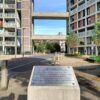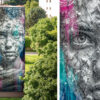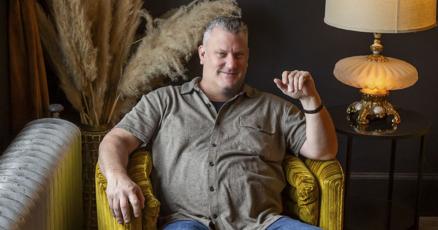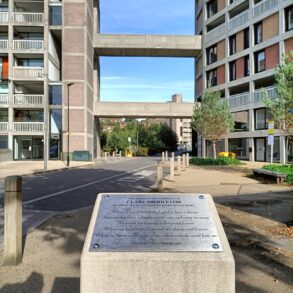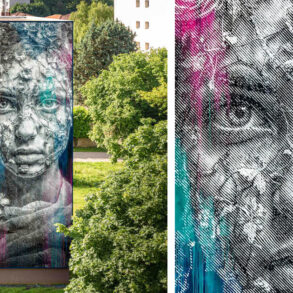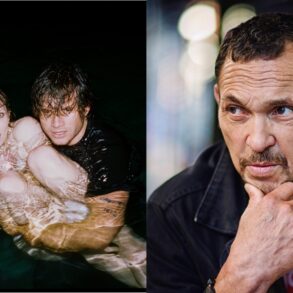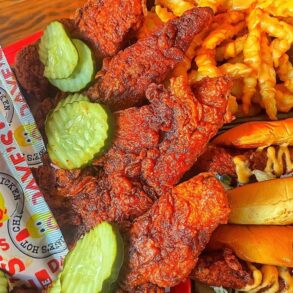
John Carswell
Apex Everett is home to a lot of things: the 900-person-capacity concert venue Kings Hall; a moodily lit, steak-centric restaurant called 16Eleven; a white-walled event space with an attention-snatching chandelier named The Gatsby Room; and the soon-to-open, 1920s-inspired cocktail lounge El Sid.
But the haunts currently filling out the 30,000-square-foot brick building built by the Knights of Columbus more than 100 years ago weren’t originally part of the plan when Northland Contractors owner John Carswell bought it in April 2022. He was, above all, looking for a place to showcase his massive DogTown Collection, which he touts as the world’s largest collection of graffiti and urban art on canvas. Amassed over the last few decades, the collection’s works date back 50 years; span the U.S.; and feature legendary graffiti-world names like Cornbread and Ichabod and pieces seen in pop-cultural touchstones like Walter Hill’s “The Warriors” (1979) and John Carpenter’s “Escape from New York” (1981).
“I have zero art talent of any kind,” Carswell told 425 while seated in a chair original to the building on a brisk late-October morning. “I grew up in Southern California, and so a lot of my friends in junior high, their older brothers were doing graffiti on the freeway walls in Santa Barbara. We would just go down there in the middle of the night, and I would be a part of watching that — but certainly not a part of doing it — and it was a fun party. Everybody’s listening to music; there’s a lot of fun. And then, about once every two or three weeks a month, the city of Santa Barbara would whitewash all those paintings that were on the backside of the walls that nobody could even see anyhow.”

Carswell was wearing a white quarter-zip and had his short silver hair neatly slicked; his unwavering zeal for the art he has painstakingly collected was infectious. When he remembered being bothered as a kid by how “these spectacular pieces” were essentially being erased from history, his chagrin still felt fresh. Carswell said he thought about graffiti less and less the older he got — he was preoccupied by the responsibilities of his day job — until one day, in the early 2000s, he was reading a magazine article about a tunnel in New York that was being scrubbed clean of its spray paint.
“It was an abandoned tunnel, and I just remember thinking to myself, ‘This is the only exclusively modern art that America has — that strictly belongs to America — and we’re whitewashing it. We’re wiping it out as fast as it’s going up,’” Carswell said.
The article reignited what had bothered him as a kid, only now he had the means and resources to do something about it.

“I decided at the time that I was going to preserve as many of the early guys’ artwork that no longer existed — they were only in pictures or books or magazines or movies,” he said. “I would try to track them down, find them, get them to put some of their more famous pieces on canvas so that, down the road, it was preserved, but also so that art students 50 years from now, when this genre will be recognized, will be able to go and say, ‘Wow, look at how they did this, and look how he did this, and look at how it evolved.’”
Carswell traversed the likes of New York, Philadelphia, Miami, and Chicago. (He doesn’t feature European works in the American Graffiti and Urban Art Conservation Project museum — the proper name for what The DogTown Collection belongs to — because the evolution of its American variant has been so inadequately spotlit.) The West Coast’s importance in graffiti and urban art is so wide-reaching that Carswell said it took about a decade of just focusing on that region to do what felt like justice. In some parts of New York and L.A. whose artists he wanted to highlight, Carswell said it could be tricky in the early days trying to make contact, with homelessness, drugs, and gangs looming heavily and with skepticism about his intentions understandably common. (He has enough of a reputation now to have built a sense of trust.)
Carswell declined to share the exact number of pieces The DogTown Collection encompasses, but he estimates it’s somewhere in the thousands. For a long time, he kept it a secret. Then he realized how crucial it was to come “out of the darkness” so that people could become familiar with the history and evolution of the art form he coveted.

When he purchased the building now known as Apex Everett, he did it specifically to turn it into a museum, thinking that Everett’s increasing reputation as an emerging Northwest art hub would make it an ideal venue. The other spaces that now help define the building — whose history Carswell and his staff, with the assistance of Revival Designs, nod to by keeping much of the furniture and décor that had remained in the facility from previous generations — came as the building was cleaned out and it became clear that it could be much more than merely a place to show off Carswell’s collection. One prominent symbol of the building’s past — a decayed, crimson-rimmed Big Apple Horse Racing sign hanging above the awning out front — was outgoing, though, soon to be replaced by a sign better speaking to the building’s current identity.
Work on the building continues; “it’s been a labor of love,” said bar manager Amanda Adamik. It consumed so much of Carswell’s time that it caused him to temporarily pause efforts on proper distribution for “Prophets, Teachers and Kings,” a documentary he wrote and produced a few years ago. Revolving around an L.A. graffiti collective — about 50 of whose members at one point in the movie travel to Carswell’s Snohomish farm to work together on a mural chronicling the life of an L.A. graffiti artist — the film got enthusiastic notices on the festival circuit around the earlier part of the decade. But more of Carswell’s focus is, for now, going to the completion of El Sid, a green-walled cocktail lounge still dusty and unkempt from construction work. Adamik said it will serve coffee during the first part of the day, then transition by night into a 21-and-over drinks-and-tapas venue. Carswell said the space is “going to be a throwback.”

Inside 16Eleven
“It’s going to be very 1920s; these walls will come out” — he gestured to the right side of the room — “so it’s much larger than this … we’re going to have mid-’70s to early ’80s punk-rock (aesthetic), too.”
A fraction of the collection’s bold, colorful pieces were displayed around the building when I visited. Carswell explained that more are typically brought out for themed shows, and that his 28-year-old daughter Glorianne, also known as “Baby G” by some of the artists included in the collection, curates and leads tours.
“We will do just a New York pioneer show; we’ll do ’69-75. There’s other times that we’ll do more of a muralist show, or we’ll do the emergence of gang graffiti, or the emergence of Chicano graffiti. It really depends on what we want to do,” he said.

The building’s exterior.
In addition to the center’s own displays, a sextet of its works can additionally be found on the sides of a specialty series of Diamond Knot Brewing Co. beer cans. The AMGRAF museum’s place in the community can also be felt through its collaborations with organizations such as the Denny Youth Center or Hope for Homies, with whom it seeks to help at-risk youth — something Carswell said he was himself at one point — through art. Carswell prefers to work with organizations like those because, unlike larger, government-funded entities, they’re “grittier,” more inclined to be hands-on. (At 6 p.m. on Friday, the center is hosting a charity gala whose raised funds will help support the AMGRAF museum and its mission.)
Although Carswell is proud of his collection, he deflected too much credit to himself and his family.
“I stumbled into (this collection); I accidentally built it … it wasn’t part of some great master plan of some intelligent human being — it was none of those things. It was just a guy that, at the moment, felt like something was important,” Carswell said. “Everybody that’s been involved, from the artists to the team to my family — The DogTown Collection is a lot bigger than one family or one crew or one guy.”
This post was originally published on this site be sure to check out more of their content.

